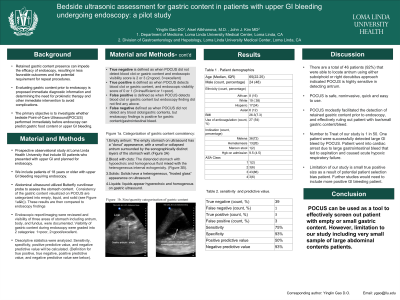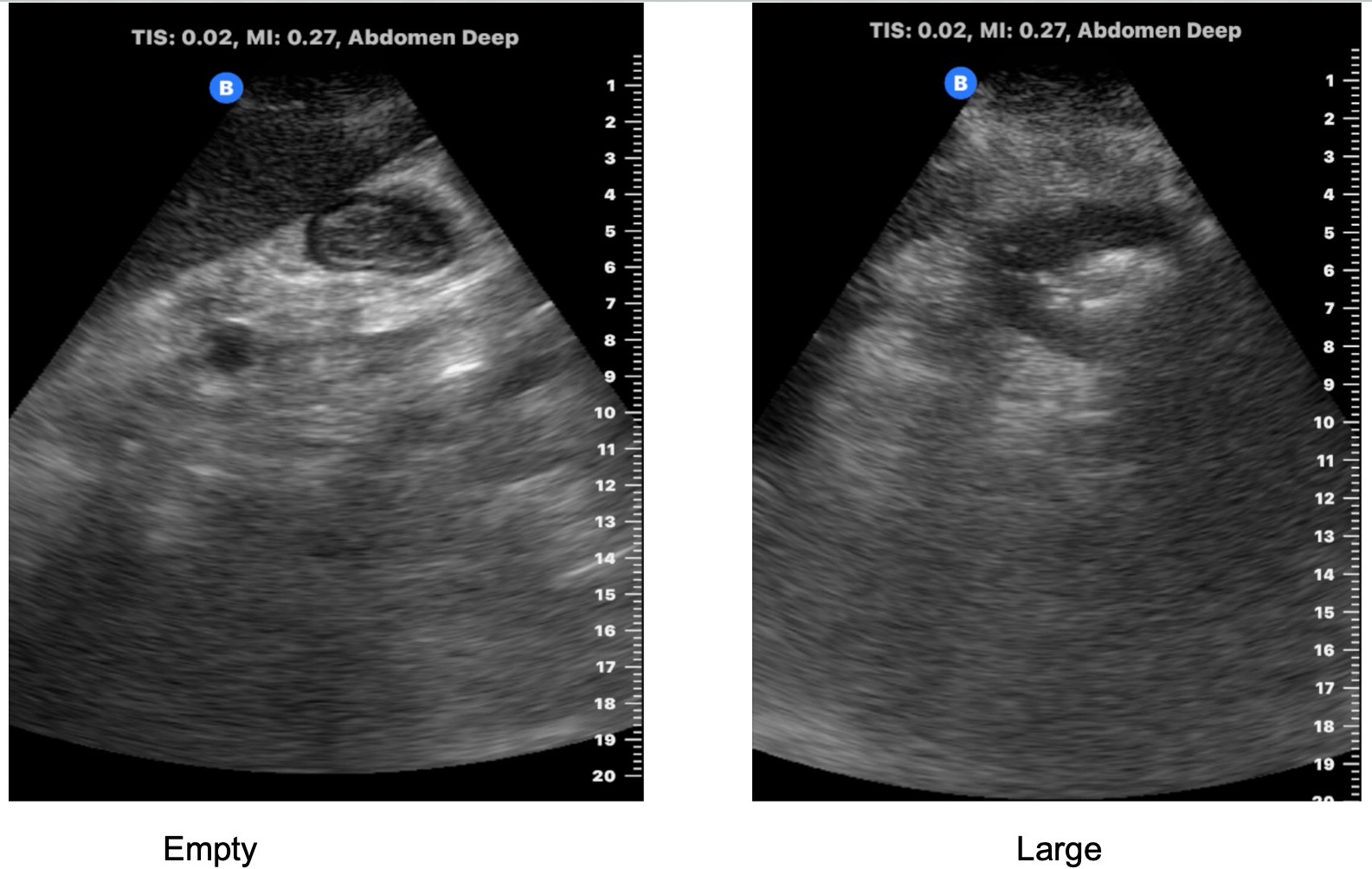Monday Poster Session
Category: GI Bleeding
P2027 - Bedside Ultrasonic Assessment for Gastric Content in Patients with Upper GI Bleeding Undergoing Endoscopy: A Pilot Study
Monday, October 23, 2023
10:30 AM - 4:15 PM PT
Location: Exhibit Hall

Has Audio
- YG
Yinglin Gao, DO
Loma Linda University Health
Loma Linda, CA
Presenting Author(s)
Yinglin Gao, DO, Aisel Alikhanova, MD, John J. Kim, MD, MS
Loma Linda University Health, Loma Linda, CA
Introduction: Optimal endoscopic visibility is important for accurate diagnosis and facilitating endoscopic therapy. The suboptimal examination could impact accuracy of the diagnosis and may result in repeat endoscopy in 5-12% of the procedures. Point-of-care ultrasound (POCUS) may be used in gastroenterology to quantify any gastric contents, to provide the clinician with immediate bedside diagnostic information, and to determine whether to give prokinetic prior to endoscopy vs delayed endoscopy to avoid repeat endoscopy. The aim of this study is to assess the diagnostic accuracy of POCUS in evaluating retained gastric content prior to endoscopy among hospitalized patients with upper GI bleed.
Methods: This is a prospective observational study conducted at Loma Linda Health University (Loma Linda, CA, USA) including patients aged 18 years or older with upper GI bleeding requiring esophagogastroduodenoscopy. Patients with gastrointestinal surgery or gastric cancer were excluded from this study. A butterfly curvilinear probe was used to assess the stomach antrum via subxiphoid approach in supine or lateral decubitus positions. The ultrasonographer recorded the presence or absence of stomach contents, as well as its characteristics (solid, fluid, or empty). Endoscopic findings were extracted from the final reports or by asking the endoscopist after the procedure (blinded). Sensitivity, specificity, positive predictive value, and negative predictive value will be calculated, along with 95% confidence intervals.
Results: Patient characteristics are seen in Table 1. One patient aborted the procedure due to cardiac arrest.
A total of 39 patients enrolled in our study. The most common indication was melena. There were 36 % of the patients who had bleeding events less than 24 hours prior to the start of endoscopy. There are 56% of the patients who ingest solid more than 8 but less than 24 hours prior to endoscopy; roughly 79% of the patients had liquid intake more than 24 hours prior to endoscopy. Median interval between time of ultrasound and time of scope was 67 minutes. The gastric antrum was visualized 82% of the time. Sensitivity was 50% in detecting large gastric content, specificity 90%, positive predictive value 25% and negative predictive value 90%.
Discussion: In this series POCUS was a modestly effective tool for screening patients with empty or small gastric content. The major limitation to our study was the very small number of patients with large abdominal contents.

Disclosures:
Yinglin Gao, DO, Aisel Alikhanova, MD, John J. Kim, MD, MS. P2027 - Bedside Ultrasonic Assessment for Gastric Content in Patients with Upper GI Bleeding Undergoing Endoscopy: A Pilot Study, ACG 2023 Annual Scientific Meeting Abstracts. Vancouver, BC, Canada: American College of Gastroenterology.
Loma Linda University Health, Loma Linda, CA
Introduction: Optimal endoscopic visibility is important for accurate diagnosis and facilitating endoscopic therapy. The suboptimal examination could impact accuracy of the diagnosis and may result in repeat endoscopy in 5-12% of the procedures. Point-of-care ultrasound (POCUS) may be used in gastroenterology to quantify any gastric contents, to provide the clinician with immediate bedside diagnostic information, and to determine whether to give prokinetic prior to endoscopy vs delayed endoscopy to avoid repeat endoscopy. The aim of this study is to assess the diagnostic accuracy of POCUS in evaluating retained gastric content prior to endoscopy among hospitalized patients with upper GI bleed.
Methods: This is a prospective observational study conducted at Loma Linda Health University (Loma Linda, CA, USA) including patients aged 18 years or older with upper GI bleeding requiring esophagogastroduodenoscopy. Patients with gastrointestinal surgery or gastric cancer were excluded from this study. A butterfly curvilinear probe was used to assess the stomach antrum via subxiphoid approach in supine or lateral decubitus positions. The ultrasonographer recorded the presence or absence of stomach contents, as well as its characteristics (solid, fluid, or empty). Endoscopic findings were extracted from the final reports or by asking the endoscopist after the procedure (blinded). Sensitivity, specificity, positive predictive value, and negative predictive value will be calculated, along with 95% confidence intervals.
Results: Patient characteristics are seen in Table 1. One patient aborted the procedure due to cardiac arrest.
A total of 39 patients enrolled in our study. The most common indication was melena. There were 36 % of the patients who had bleeding events less than 24 hours prior to the start of endoscopy. There are 56% of the patients who ingest solid more than 8 but less than 24 hours prior to endoscopy; roughly 79% of the patients had liquid intake more than 24 hours prior to endoscopy. Median interval between time of ultrasound and time of scope was 67 minutes. The gastric antrum was visualized 82% of the time. Sensitivity was 50% in detecting large gastric content, specificity 90%, positive predictive value 25% and negative predictive value 90%.
Discussion: In this series POCUS was a modestly effective tool for screening patients with empty or small gastric content. The major limitation to our study was the very small number of patients with large abdominal contents.

Figure: Figure1. Gastric quantity small (left) vs large (right)
Disclosures:
Yinglin Gao indicated no relevant financial relationships.
Aisel Alikhanova indicated no relevant financial relationships.
John Kim indicated no relevant financial relationships.
Yinglin Gao, DO, Aisel Alikhanova, MD, John J. Kim, MD, MS. P2027 - Bedside Ultrasonic Assessment for Gastric Content in Patients with Upper GI Bleeding Undergoing Endoscopy: A Pilot Study, ACG 2023 Annual Scientific Meeting Abstracts. Vancouver, BC, Canada: American College of Gastroenterology.
